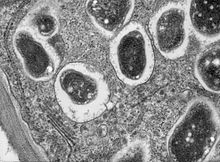
A symbiosome is a specialised compartment in a host cell that houses an endosymbiont in a symbiotic relationship.[1]
The term was first used in 1983 to describe the vacuole structure in the symbiosis between the animal host the Hydra, and the endosymbiont Chlorella. Symbiosomes are also seen in other cnidaria-dinoflagellate symbioses, including those found in coral-algal symbioses. In 1989 the concept was applied to the similar structure found in the nitrogen-fixing root nodules of certain plants.[1]
The symbiosome in the root nodules has been much more successfully researched due in part to the complexity of isolating the symbiosome membrane in animal hosts.[1] The symbiosome in a root nodule cell in a plant is an organelle-like structure that has formed in a symbiotic relationship with nitrogen-fixing bacteria. The plant symbiosome is unique to those plants that produce root nodules.[2] The majority of such symbioses are made between legumes and diazotrophic Rhizobia bacteria. The rhizobia-legume symbioses are the most studied due to the importance in agriculture.[3][4]
Each symbiosome in a root nodule cell encloses a single rhizobium that differentiates into a bacteroid. However, in some cases a symbiosome may house several bacteroids.[5] The symbiosome membrane, or peribacteroid membrane, surrounds the bacteroid membrane, separated by a symbiosome space. This unit provides an inter-kingdom, micro-environment for the production of nitrogen for the plant,[3][6] and the receipt of malate for energy for the bacteroid.[7]
- ^ a b c "Isolation of Symbiosomes and The Symbiosome Membrane Complex from The Zoanthid Zoanthus Robustus". ResearchGate.
- ^ Emerich, DW; Krishnan, HB (15 May 2014). "Symbiosomes: temporary moonlighting organelles". The Biochemical Journal. 460 (1): 1–11. doi:10.1042/BJ20130271. PMID 24762136.
- ^ a b Coba de la Peña, T; Fedorova, E; Pueyo, JJ; Lucas, MM (2017). "The Symbiosome: Legume and Rhizobia Co-evolution toward a Nitrogen-Fixing Organelle?". Frontiers in Plant Science. 8: 2229. doi:10.3389/fpls.2017.02229. PMC 5786577. PMID 29403508.
- ^ Zahran, HH (December 1999). "Rhizobium-legume symbiosis and nitrogen fixation under severe conditions and in an arid climate". Microbiology and Molecular Biology Reviews. 63 (4): 968–89, table of contents. doi:10.1128/mmbr.63.4.968-989.1999. PMC 98982. PMID 10585971.
- ^ Haag, AF; et al. (May 2013). "Molecular insights into bacteroid development during Rhizobium-legume symbiosis". FEMS Microbiology Reviews. 37 (3): 364–83. doi:10.1111/1574-6976.12003. PMID 22998605.
- ^ Andrews, M; Andrews, ME (26 March 2017). "Specificity in Legume-Rhizobia Symbioses". International Journal of Molecular Sciences. 18 (4): 705. doi:10.3390/ijms18040705. PMC 5412291. PMID 28346361.
- ^ Schulze, J.; et al. (1 November 2002). "Malate plays a central role in plant nutrition". Plant and Soil. 247: 133–139. doi:10.1023/A:1021171417525. S2CID 13833130.